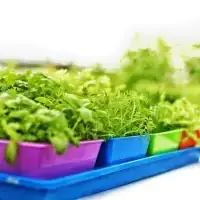Choosing your Microgreen Trays

Discover the Ideal Microgreen Trays for Your Needs - A Comprehensive Guide
Wondering which tray suits your microgreen cultivation best? Our extensive guide on Bootstrap Farmer trays has you covered. Uncover the perfect trays for your specific needs.
Propagation trays are versatile, ideal for nurturing microgreens, germinating seedlings in soil blocks, or growing fodder for poultry. Unsure about the size or type of tray that's right for you?
Dive into our detailed guide below to explore various propagation trays available and receive tailored advice for your use.
Do You Need Both Perforated and Solid Microgreen Trays for Soil Blocks?
Absolutely, to effectively grow microgreens or soil blocks, you'll need both types of trays. Regardless of the tray size, it's essential to have a perforated tray for your soil and seeds, and a solid one for water retention.
The sizes necessary will depend on your gardening goals. Our comprehensive list and FAQs below will assist in selecting the perfect microgreen trays for your plans.
Choosing the Right Microgreen Tray Size
Follow our guide to determine the most suitable tray size for your needs. If you're contemplating between mesh trays and perforated trays for certain crops, read on for more insights.
5x5 Grow Tray: This compact tray is ⅛ the size of our heavy-duty 1020 tray, excellent for subscription microgreen sales, individual sales, or growing small herb quantities at home. Designed to fit 8 within a 1020 2.5” deep tray, it's also available in a shallower version.
1010 Shallow Microgreen Tray (With and Without Holes): Half the size of a 1020 tray, these trays offer the same style and durability. Two shallow trays fit comfortably inside a 1020 tray, saving time during watering. Ideal for limited growing spaces, the 1010 with holes can nest inside a 1010 without holes, and is suitable for flood and drain systems.
1010 Deep Tray (With Holes): This 2.5” deep tray, half the size of a 1020 tray, can nest inside a 1010 Deep Tray without holes or two can fit in a heavy-duty 1020 2.5” deep tray. Also compatible with flood and drain systems.
1020 Shallow Mesh: The 1” deep microgreen mesh tray offers superior drainage, perfect for larger root varieties or top-watering plants like peas and sunflowers. Its design prevents water pooling and is suitable for bottom watering or flood and drain systems.
1020 Deep Mesh: A 2.5” deep mesh tray designed for larger soil block propagation and taller microgreen varieties. It fits perfectly into 1020 2.5” Deep Without Hole Trays for bottom watering or can be used in flood and drain systems. Also ideal for fodder and wheatgrass.
1020 Shallow Microgreen Tray (With & Without Holes): These popular microgreens trays come in vibrant colors. The no-hole version has 32 small holes for drainage and bottom watering. The shallow tray with holes nests into the one without holes perfectly.
1020 Extra Strength 2.5” (With & Without Holes): Ideal for varieties requiring more soil or for propagation, the 1020 Deep with holes nests into the 1020 Deep without holes for efficient bottom-watering.
Best Trays for Commercial Microgreens
The choice of trays for selling microgreens depends on your setup and marketing strategy. Whether selling harvested microgreens in containers or offering live trays and subscription services, consider your indoor or tunnel growing environments, rack or table setups, and flood and drain systems. 1020 trays are optimal for harvested greens, while 5x5 or 1010 trays are great for live tray services.
Ideal Trays for Home Microgreens Cultivation
Select trays based on your household size and microgreen consumption frequency. 1010 trays are great for small families, while 1020 trays suit larger families. Choose heavy-duty, food-safe plastic trays for durability and ease of cleaning.
Necessity of Perforated and Solid Trays
For successful microgreen cultivation, both perforated and solid trays are essential. This applies even for outdoor growing in tunnels, as bottom watering reduces fungal growth and crop loss. The only exception is for flood and drain systems like our Automated Grow Rack.
For more insights on optimal microgreen watering techniques at different growth stages, explore our linked article.
Mesh Trays vs. Trays with Holes: Understanding the Differences
Trays with holes are standard for most microgreens, providing adequate moisture retention and support for growing media. Mesh trays, on the other hand, are ideal for larger-seeded crops like pea shoots and wheatgrass, which require more root space and drainage

